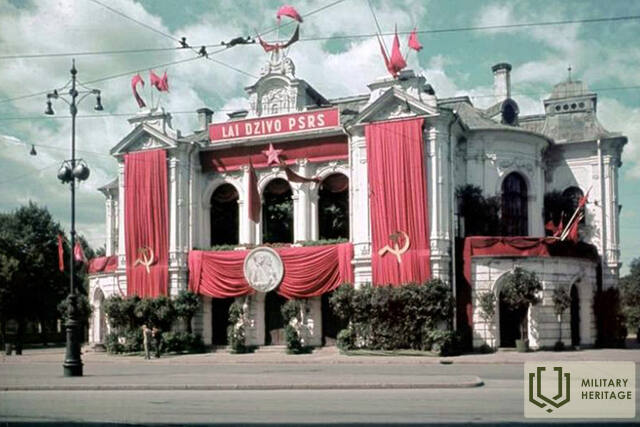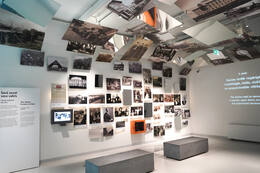Dėl Latvijos okupacijos
1940 m. nepriklausomos Latvijos valstybės egzistavimą nutraukė Sovietų Sąjungos okupacija ir aneksija, arba inkorporacija, į Sovietų Socialistinių Respublikų Sąjungą (SSRS).
„Atėjo 1940-ieji, birželio 17-oji. Į knygyną įėjo ponia ir pasakė, kad stoties aikštėje stovi rusiškas tankas. Nuėjau pažiūrėti. Ten stovėjo rusiškas tankas, tanko viduje sėdėjo tankininkas, kojomis įkišęs kojas, aplink stovėjo keli žmonės, nieko nevyko. Supratau, kad įvyko didelių pokyčių.“
Vėlyvą popietę vėl ten nuėjau – į stoties aikštę. Vienoje prekių stoties pusėje stovėjo vienaukščiai pastatai su parduotuvėmis, gana prašmatniomis parduotuvėlėmis, ir buvo šie dideli stikliniai langai. Mačiau kelis berniukus, mėtančius akmenis į šiuos langus, ir vienas sušuko: „Jau gavau šešis!“
„Sklido gandai, kad kažkas nutiko aplink „Metropole“ viešbutį, buvo nušauti du demonstrantai, anksčiau žinojau jų vardus. Kitą rytą mieste, galima sakyti, buvo paskelbta karo padėtis – sargybiniai, policininkai su karabinais, o šalia jų – sovietų armija, bet Esplanadoje... Padėtis buvo įtempta, taip pat buvo areštų. Buvo mobilizuoti sargybiniai iš kaimo.“
„Kada pradėjo protestuoti pasiuntiniai Londone ir Vašingtone? Ne birželio 17 ar 21 d., daug vėliau. Iš pradžių atrodė – ką man sakė generolas Dambītis – kad bus nepriklausoma Latvija, draugystė su Sovietų Sąjunga be Ulmanio, ir tuo viskas baigsis.“
„Kaip gudriai buvo sužaista – visose trijose respublikose pirmosiose vyriausybėse nėra nė vieno komunisto. Tada pradeda rodytis vietiniai komunistai, tada pradeda rodytis latviai iš Rusijos, kurie buvo pasiųsti viceministrais. Tada su rinkimais sužaidžiamas pokštas.“
Žinote, pirmomis dienomis, jei kas nors šaukdavo: „Tegyvuoja Sovietų Latvija!“, komunistai juos pravardžiavo – tai buvo draudžiama. Rinkimai vykdavo greitai, o nuo Ulmanio laikų pase būdavo skiltis, kurioje klausiama, ar dalyvavai rinkimuose – žinau, kad daug žmonių ėjo, nes bijojo – jei neis, galėjo kilti bėdų, nepriklausomai nuo rezultato. Devyniasdešimt septyni procentai yra absurdiška.“
Prisiminimai buvo išleisti 2011 metais Atos Klimovičs knygoje „Asmeninė Latvija“.
Susijusi laiko juosta
Susijusios temos
Susijusios vietos
Latvijos okupacijos muziejus
Muziejuje eksponuojama Latvijos istorija nuo 1940 iki 1991 m., nacistinės Vokietijos ir Sovietų Sąjungos okupacijos laikotarpiu. „Ateities namai“ – tai žinomo Amerikos latvių architekto Gunāro Birkertaus suprojektuoto Okupacijos muziejaus rekonstrukcijos ir išplėtimo projektas, taip pat nauja muziejaus ekspozicija. Ekspoziciją „Čekos istorija Latvijoje“ sukūrė Okupacijos muziejus, ji yra buvusiame SSRS Valstybės saugumo komiteto (KGB) pastate „Kampiniame name“. Latvijos okupacijos muziejus buvo įkurtas 1993 m. Jis pasakoja ilgai slėptą Latvijos valstybės, tautos ir žemės likimo istoriją dviejų užsienio totalitarinių valstybių okupacijos laikotarpiu nuo 1940 iki 1991 m. 2020 m. pabaigoje muziejuje buvo daugiau nei 70 000 įvairių istorinių eksponatų (dokumentų, nuotraukų, rašytinių, žodinių ir daiktinių įrodymų, daiktų ir atminimo dovanų). Muziejaus specialistai įrašė daugiau nei 2400 vaizdo įrašų, todėl tai viena didžiausių okupacijos kolekcijų Europoje. Latvijoje, Lietuvoje ir Estijoje klostęsi įvykiai aiškiai parodo, ką tautoms teko ištverti valdant dviem totalitariniams režimams.







